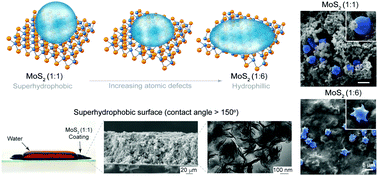Science Daily July 2, 2019
Current superhydrophobic materials require alteration to the chemistry or topography of the surface to work which limits their use. Researchers at Texas A&M adopted a ‘nanoflower-like’ assembly of Molybdenum disulfide (MoS2) atomic layers to protect the surface from wetting. With their hexagonal packed layer 2D materials repel water adherence, however, a missing atom from the top layer can allow easy access to water molecules by the next layer of atoms underneath making it transit from hydrophobic to hydrophilic. For biomedical applications specifically, the study demonstrated that blood and cell culture media containing proteins do not adhere to the surface. It could have widespread applications in the biomedical field including biosensing, lab-on-a-chip, blood-repellent, anti-fouling and self-cleaning applications…read more. Open access TECHNICAL ARTICLE

Credit: Chemical Communications, 2019; DOI: 10.1039/c9cc00547a